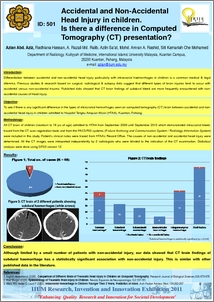Abd. Aziz, Azian and Hassan, Radhiana and Md. Ralib@Md. Raghib, Ahmad Razali and Sa'at@Yusof, Azlin and Abdul Rashid, Mohd Amran and Che Mohamed, Siti Kamariah
(2011)
Accidental and non-accidental head injury in children.
Is there a difference in Tomography (CT) presentation?
In: IIUM Research, Invention and Innovation Exhibition 2011, 9-10 February 2011, IIUM Gombak.
(Unpublished)
![[img]](http://irep.iium.edu.my/style/images/fileicons/application_pdf.png)  Preview |
|
PDF (Accidental and Non-Accidental Head Injury in children. Is there a difference in Tomography (CT) presentation?)
- Presentation
Download (148kB)
| Preview
|
Abstract
Introduction:
Differentiation between accidental and non-accidental head injury particularly with intracranial haemorrhages in children is a common medical & legal dilemma. Previous studies & research based on surgical, radiological & autopsy data suggest that different types of brain injuries tend to occur with accidental versus non-accidental trauma. Published data showed that CT brain findings of subdural bleed are more frequently encountered with nonaccidental
causes of head injury.
Objective:
To see if there is any significant difference in the types of intracranial hemorrhages seen on computed tomography (CT) brain between accidental and nonaccidental head injury in children admitted to Hospital Tengku Ampuan Afzan (HTAA), Kuantan, Pahang.
Methodology:
All CT brain of children (newborn to 18 yrs of age)admitted to HTAA from September 2009 until September 2010 which demonstrated intracranial bleed,traced from the CT scan registration book and from the PACS/RIS systems (Picture Archiving and Communication System / Radiology Information System)were included in this study. Patient’s clinical notes were traced from HTAA’s Record Office. The causes of non-accidental and accidental head injury were determined. All the CT images were interpreted independently by 2 radiologists who were blinded to the indication of the CT examination. Statistical analysis were done using SPSS version 12.
Conclusion:
Although limited by a small number of patients with non-accidental injury, our data showed that CT brain findings of
subdural haemorrhage has a statistically significant association with non-accidental injury. This is similar with other published data in the literature.
Actions (login required)
 |
View Item |


 Download Statistics
Download Statistics Download Statistics
Download Statistics